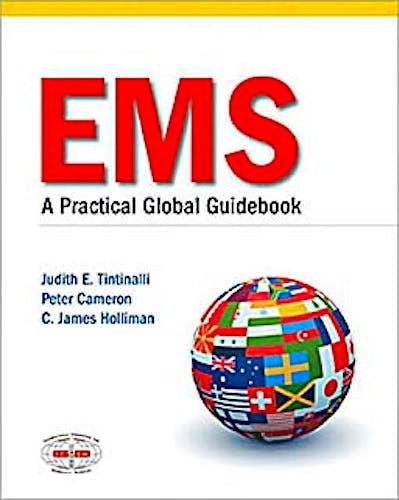

No hay productos en el carrito



EMS. A Practical Global Guidebook
Tintinalli, J. — Cameron, P. — Holliman, J.
1ª Edición Agosto 2010
Inglés
Tapa blanda
668 pags
1200 gr
18 x 26 x 2 cm
ISBN 9781607950431
Editorial PEOPLE'S MEDICAL PUBLISHING HOUSE (PMPH)
LIBRO IMPRESO
-5%
65,99 €62,69 €IVA incluido
63,45 €60,28 €IVA no incluido
Recíbelo en un plazo de
2 - 3 semanas
Description
EMS: A Practical Global Guidebook is the first international resource for EMS services edited by an international team of experts.
The World Health Organization recognizes that each year more than 100 million people worldwide sustain injuries, that more than five million people die from violence and injury, and that 90% of the global burden of violence and injury mortality occurs in low- and middle-income countries.
The WHO also recognizes that improved organization and planning for provision of trauma and emergency care is an essential part of integrated health-care delivery that it plays an important role in preparedness for, and response to, mass-casualty incidents. EMS organization and planning lowers mortality, reduces disability, and prevents other adverse health outcomes arising from the burden of everyday injuries.
In response to a growing need for coordination and communication across nations and cultures, this book is designed to help the Global EMS community come together to establish and develop coordinated components of global and national EMS systems.
Key Features
- International editorial and author team
- Highly illustrated with four-color illustrations and photographs
- Extensive, descriptive procedures section
- Website with updated content and links to videos
- First International resource for EMS physicians, paramedics, EMTs, and health policymakers. Comprehensive in theory and in practice.
- Chapters written by world authorities in prehospital care, with narratives describing the challenges to EMS development around the world
- Global focus to EMS organization to match unique needs and environments
CONTENTS
PART 1 FOUNDATIONS
- CHAPTER 1
Standard EMS Terms and Definitions - CHAPTER 2
International EMS Development - CHAPTER 3
Historical Timeline of International Events - CHAPTER 4
Structures of Different National
EMS Systems - CHAPTER 5
EMS Interactions with
Governments - CHAPTER 6
EMS and Public Services: Lessons
Learned in Lebanon - CHAPTER 7
EMS Role in Public Health and
Public Education - CHAPTER 8
EMS Research
PART 2 BASICS OF ORGANIZATION
- CHAPTER 9
First Responders and Bystanders - CHAPTER 10
Staffing of Ambulances - CHAPTER 11
EMS Medical Directors - CHAPTER 12
Training Programs and Standardized Curricula - APPENDIX 1
An EMS-Specific Syllabus - APPENDIX 2
Example of History and Examination
Section Taken from an EMS-Specific
Curriculum - APPENDIX 3
Example of Core Module Taken from
Chinese University of Hong Kong
Masters of Science for Prehospital and Emergency Care - CHAPTER 13
EMS Health, Safety, and Wellness Issues - CHAPTER 14
Dispatch and Communication Systems - CHAPTER 15
Patient Data Records and Patient Handover - CHAPTER 16
Development of an EMS Quality
Improvement Program - CHAPTER 17
EMS Vehicles - CHAPTER 18
Ambulance Station Design - CHAPTER 19
EMS Equipment - CHAPTER 20
Financing of EMS Systems and Cost-Effectiveness
PART 3 PROTOCOLS AND PROCEDURES
- CHAPTER 21EMS Clinical Care Protocols
- APPENDIX 1Example of a Protocol for Body Substance
Isoolation Guidelines - CHAPTER 22
Airway Management - CHAPTER 23
Parenteral Access: IV, IO, IM,
Rectal, Nasal - CHAPTER 24
Cardiac Defibrillation and External Pacing - CHAPTER 25
Therapeutic Hypothermia After Outof-Hospital Cardiac Arrest - CHAPTER 26
ECG Interpretation - CHAPTER 27
Prehospital Fibrinolysis - CHAPTER 28
Prehospital Stroke Assessment - CHAPTER 29
Helmet Removal - CHAPTER 30
Spinal Immobilization - CHAPTER 31
Stabilization of Pelvic Fractures - CHAPTER 32
Extremity Splinting and Care of Open Fractures - CHAPTER 33
Pulseless Extremity - CHAPTER 34
Impaled Objects - CHAPTER 35
Hemorrhage Control - CHAPTER 36
Eye Injuries - CHAPTER 37
Burns - CHAPTER 38
Snake Bites - CHAPTER 39
Prehospital Pain Management - CHAPTER 40
Obstetrics and Gynecology - CHAPTER 41
Pediatric Procedures - CHAPTER 42
Trauma Assessment
PART 4 SPECIAL SITUATIONS
- CHAPTER 43
Pediatric Care in EMS - CHAPTER 44
EMS Violence - CHAPTER 45
EMS in Rural and Wilderness Areas - CHAPTER 46
Military EMS Systems - CHAPTER 47
Disasters and HazMat - CHAPTER 48
Tactical EMS Medicine - CHAPTER 49
Aeromedical Programs
APPENDIX
Web Links and Resources
Index
Authors
Judith E. Tintinalli, MD, MS
Department of Emergency Medicine,
University of North Carolina at Chapel Hill
Professor and Chair Emeritus, Department of Medicine,
School of Medicine, Chapel Hill, NC
Peter Cameron MBBS, MD, FACEM
Monash University
Medicine, Nursing and Health Sciences
Academic Director of the Emergency and Trauma Centre, The Alfred Hospital,
Head of the Prehospital, Emergency and Trauma Group and Associate Director of
the National Trauma Research Institute
James Holliman, M.D.
Center for Disaster and Humanitarian Assistance Medicine, Uniformed Services
University of the Health Sciences
Clinical Professor of Emergency Medicine, George Washington University
Program Manager, Afghanistan Healthcare Sector Reachback Project; Professor
of Military and Emergency Medicine, Uniformed Services University of the Health
Sciences
© 2025 Axón Librería S.L.
2.149.0